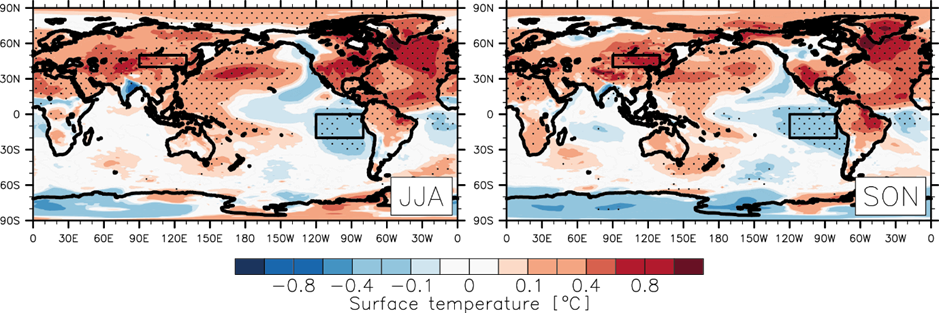North East Asia has warmed substantially after the mid-1990s leading to an increase in temperature extremes and to societal impacts (Dong et al., 2016). Predicting the variability of the North East Asian climate is therefore of primordial interest since it would help the population to anticipate strong climatic events.

Figure 1: Anomaly correlation coefficient skill score (ACC) for SAT in DePreSys3 hindcasts (using NCEP as observations) in extended summer (JJAS) for year 2–5 lead-times. The ACC calculated after a linear trend is removed at each grid-point. Stippling indicates that the ACC is different to zero at the 95% confidence level according to a Monte-Carlo procedure. Figure from Monerie et al. (2017).
Climate models allow simulating climate and projecting its short-term to long-term evolutions. We used the decadal prediction system DePreSys3 (Dunstone et al., 2011) and assessed how the model is able to predict, retrospectively, the observed temperature, up to 5 years ahead (Monerie et al., 2017). The correlation between the observed temperature and the simulated temperature (i.e. the anomaly correlation coefficient) shows that the climate model satisfactorily reproduces the observed temperature over many places, including North East Asia and the North Atlantic Ocean (Fig. 1).
Further analyses have highlighted a statistical co-variability between the temperature over East Asia and the variability of the temperature over the North Atlantic Ocean, with a positive phase of the North Atlantic Multidecadal Variability (i.e. the low-frequency variability of the North Atlantic sea surface temperature) associated with a warming over North East Asia, in agreement with Lin et al. (2016) and Sun et al. (2019). Prediction systems have good skill in retrospectively predicting the temperature over the North Atlantic Ocean up to 5 years ahead (García-Serrano et al., 2015) and we thus propose that such climate models and experimental protocols could be useful to predict the low-frequency variability of the temperature over East Asia.

Figure 2: Impact of AMV on (top panels) surface temperature (°C), in (left) JJA and (right) SON. Stippling indicates that changes are significantly different to zero according to a Student’s t-test at the 95% confidence level.
The mechanisms linking the North Atlantic Ocean to North East Asia have then been assessed by performing a set of sensitivity experiments, following (Boer et al., 2016), and using the MetUM-GOML2 climate model (Hirons et al., 2015). We confirm, that in a climate model, a warming of the North Atlantic Ocean is associated with an increase in temperature over North East Asia (Fig. 2). We identify two mechanisms, which link the North Atlantic Ocean to East Asia. First, the warming of the Atlantic Ocean is associated with a perturbation of the circumglobal teleconnection pattern (i.e. the atmospheric circulation over the Northern Hemisphere) (Ding and Wang, 2005; Beverley et al., 2019). Second, the Atlantic Ocean is able to force a part of the variability of the Pacific Ocean, leading to an excess in precipitation over the Philippines, and to the propagation of a Rossby wave, which propagate over the western Pacific Ocean. Both mechanisms are able to impact East Asia, through increasing heat advection and incoming surface shortwave radiation locally.
Our ongoing results show that we might be able to increase our ability to predict climate over East Asia by improving our knowledge on the impacts and variability of the North Atlantic Ocean.
